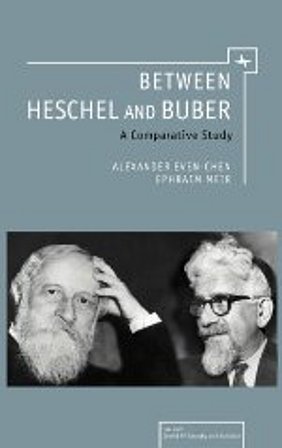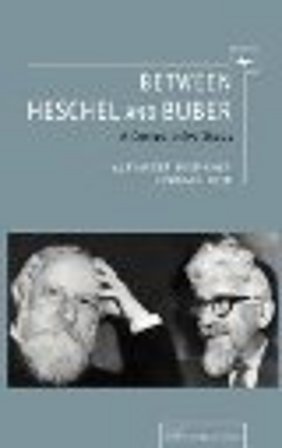Between them, articles relating to Martin Buber and Abraham Joshua Heschel account for over nine hundred entries in the Jewish National Library’s Index of Articles on Jewish Studies. Add to this the steady stream of books concerning either Buber or Heschel, and the sheer bulk of the bibliography is even more daunting. Comparisons between the two thinkers, however, are rare.[1] None of the previous attempts to set these two figures alongside each other in search of affinities and contrasts compares in scope and depth to the volume under review. By undertaking a well-structured and thoughtful comparison of the men they describe as “giant and committed thinkers of the twentieth century,” Alexander Even-Chen and Ephraim Meir have achieved a significant feat. Rather than being one more entry in a crowded field, Between Heschel and Buber deserves a special place within a rapidly burgeoning literature.
As a collaboration between a well-respected scholar of Franz Rosenzweig, Buber, and Emmanuel Levinas (Meir) and the author of a groundbreaking work on Heschel in Hebrew (Even-Chen), the production of this work mirrors its topic. It reads like a conversation between experts in their respective fields considering the thought of their subjects on a number of key themes, each of which merits a chapter--the conception of man, the approach to God, the Bible and its interpretation, the commandments, Hasidism, Zionism, and Christianity. This structure is well conceived, and it provides the reader with a useful grounding in the thought of both Buber and Heschel as applied to these central topics. Further, the book’s introduction and conclusion are both excellent, ensuring a worthwhile read for the dilettante browser and dedicated reader alike.
This book notes a number of distinctions between Heschel and Buber. Even-Chen and Meir argue persuasively that the two thinkers understood human interaction with the divine in different ways. We learn from an analysis of Heschel’s poetry that “by intermingling God’s existence and his own human existence, Heschel substantially differ[ed] from Buber” (p. 32). Heschel’s God confronted the prophet, who identified with divine pathos, while in Buber’s view the link to divine presence was accessed through dialogical connection between persons. Heschel’s pointed rejection of I-Thou terminology has its roots in this theological dispute.
A second distinction relates to the area of practice. Buber preferred religiosity to religion, while Heschel “showed the tension between both realities,” and affirmed the concept of mitzvah both in his thought and in his life (p. 160). While both men expressed the inadequacy of dessicated ritual, one concluded that it was to be abandoned, while the other strove to revive it from within.
Some distinctions are underplayed in the book. Heschel, we learn in chapter 3, highlighted the continuity between the biblical and rabbinic periods, while Buber downplayed the significance of the latter. In my view this is an insight of greater resonance and significance than the role afforded it by Even-Chen and Meir. It is well illustrated by an anecdote recorded by Jacob Neusner which did not find its way into this work. Neusner recounts that Heschel told him that he gave Buber a copy of the Talmud in honor of Buber’s sixtieth birthday. The recipient of the gift is reported to have thanked the donor, adding: “I’ve always wanted one.”[2] While it is not possible to ascertain the literal veracity of the tale, it is in any case significant that Heschel told it. It implies what other statements attributed to Heschel also make clear, that Buber’s attempt to leapfrog such a central aspect of Jewish literature was rejected by Heschel, whose conception of Jewish history contained no Dark Ages, and whose works contain references to every era of Jewish creativity. Buber, in contrast, privileged certain epochs in Jewish history and paid others relative disregard.
One important insight in this book concerns Heschel’s pejorative preoccupation with the realm of the symbolic. The authors argue that Heschel’s “protest against the use of God as a symbol could be understood mainly as a protest against Buber’s thought in his early predialogical period” (p. 68). Readers of Heschel have offered a wide range of explanations of Heschel’s anti-symbolic stance, and this suggestion is a valuable addition to the debate. Meir and Even-Chen also suggest many parallels between their two subjects, commenting on a number of occasions that words attributed to one would not have been out of place in the mouth of the other. Some insights are particularly interesting, such as the comparison between Heschel’s 1939 article on the language of prayer and Buber’s conception of the Bible.
Notwithstanding the books many strengths and undoubted significance, it has one or two surprising omissions and idiosyncracies. The authors have almost nothing to say about Heschel’s reading of the Bible. They are surely right to play up Buber’s remarkable contribution to the encounter of the today’s reader with the Hebrew Bible, but nothing is said of Heschel’s approach to the Bible, suggesting instead that he focused on the Oral Torah. As some scholars, including Jon D. Levenson and Dror Bondi, have demonstrated, there is much to be said about the ways in which Heschel read and deployed the Hebrew Bible, but almost none of this discourse finds its way into the current volume.[3]
Another curious absence can be found in the chapter on Hasidism. Meir and Even-Chen explicate much about the ways in which Buber and Heschel understood the phenomenon of Hasidism, and their presentation is characteristically full of helpful and judicious comments. However, very little is said about Heschel’s scholarly contributions to the history of early Hasidism. Nor is mention made of Heschel’s explicit references to the (Gershom) Scholem-Buber controversy.
Maurice Friedman has recorded two comments made by Heschel in the wake of Scholem’s critique of Buber’s approach. First, he notes that “Abraham Joshua Heschel was extremely distressed by the nature of these attacks. ‘You know I do not like some of what Buber has done with Hasidism,’ Heschel said to me, ‘but whom else do we have like him?’” Second, in response to a question from a group of African students whether they should study Scholem or Buber, he states that “Heschel ... a scholar whose knowledge and understanding was second to none, said: ‘No, if you want to know Hasidism as it was, begin with Buber.’”[4] Inherent in these remarks is some of the complexity that characterized Heschel’s relationship--both personal and intellectual--with each of these two figures. In both cases, the preference for Buber is accompanied by a certain reservation: after all, one should begin with Buber, but not necessarily settle for him. These comments recorded by Heschel in relation to his erstwhile teacher do not find their way into this work.
That there is yet more to be said about the relationship between these two giants of Jewish thought after the publication of this important work should come as no surprise. Without doubt, Even-Chen and Meir have moved the discourse concerning the interface between Heschel and Buber to a new level of sophistication and depth.
Heschel entitled a chapter in Passion for Truth (1973) devoted to a comparison between the Kotzker Rebbe and Søren Kierkegaard “The Affinity of Strangers.” Between Heschel and Buber describes both resonant affinities and significant contrasts between two of the most important figures in twentieth-century Jewish thought. Theirs was not a symmetrical relationship--Buber exercised a far greater influence on Heschel than did Heschel on Buber. Now that interest in the younger man has begun to rival and even overshadow concern with the older, it is a good time to consider the two in proximity. While our reading of each man is unlikely to be transformed by this comparison, Even-Chen and Meir have made a unique and important contribution to our understanding of an important nexus in modern Jewish thought.



